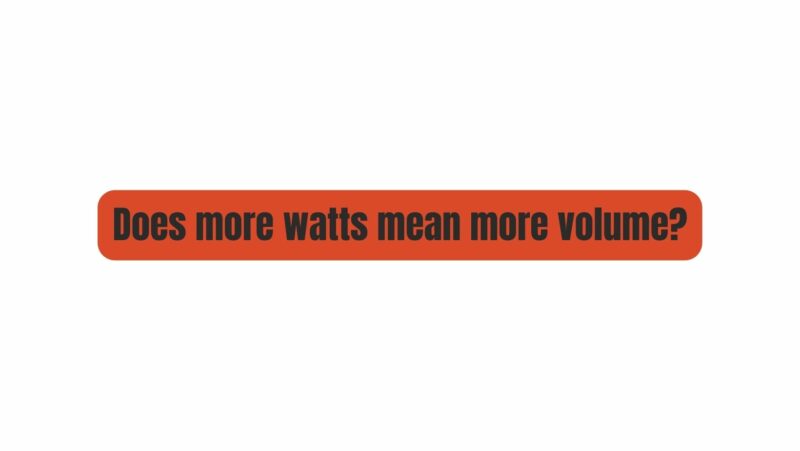The relationship between amplifier power (measured in watts) and volume is a topic of great interest and debate among audio enthusiasts, musicians, and consumers. It’s a common misconception that more watts automatically mean more volume, but the reality is more complex. To fully grasp this concept, we need to examine how amplifier power, speaker efficiency, and other factors interact to determine the loudness of a sound system.
1. Understanding Amplifier Power
Amplifier power, typically referred to simply as “wattage,” is a measure of how much electrical energy an amplifier can convert into acoustic energy (sound). It is one of the key specifications used to describe an amplifier’s performance. Amplifier wattage can range from a few watts for small practice amps to several thousand watts for professional concert systems.
2. The Decibel Scale
To understand the relationship between amplifier power and volume, it’s important to introduce the decibel (dB) scale. The decibel scale is a logarithmic unit of measurement used to express the ratio of one value to another, often in the context of sound intensity. It allows us to describe sound levels in a more meaningful way than using linear measurements.
3. Speaker Efficiency
Speaker efficiency, often measured in decibels per watt per meter (dB/W/m), quantifies how effectively a speaker converts electrical power into acoustic sound. More efficient speakers require less amplifier power to produce a certain volume level, while less efficient speakers need more power.
4. The 3 dB Rule
One critical point to understand is the 3 dB rule. It states that to double the perceived loudness of a sound, you need to increase the power by a factor of ten. Conversely, to halve the perceived loudness, you need to reduce the power by a factor of ten. This rule highlights the logarithmic nature of the decibel scale and the relationship between power and perceived volume.
5. The Law of Diminishing Returns
Increasing amplifier power does result in more volume, up to a point. However, as you add more power, you may notice that the increase in volume becomes less and less noticeable. This phenomenon is known as the law of diminishing returns. To double the volume, you may need significantly more than double the power. This is due to the 3 dB rule and the fact that our perception of loudness is not linear.
6. Matching Amplifier Power and Speaker Efficiency
The key to achieving the desired volume level is matching the amplifier’s power output to the speaker’s efficiency. In other words, you want to ensure that the amplifier can provide enough power to drive the speakers to the desired volume without overloading them. Using an amplifier with too much power for highly efficient speakers can result in excessive volume, which may lead to speaker damage if not controlled properly.
7. Practical Examples
Let’s consider a couple of practical examples to illustrate these concepts:
- Example 1: You have a small practice amp with 10 watts of power and highly efficient speakers rated at 96 dB/W/m. In this case, 10 watts can produce a reasonable practice volume.
- Example 2: For a live music scenario, you might have a 100-watt amplifier with speakers rated at 90 dB/W/m. Even though the amplifier has ten times the power of the practice amp, it may not sound ten times louder. The 3 dB rule means that it will only be about twice as loud as the 10-watt setup.
8. Real-World Considerations
In real-world applications, other factors can influence perceived volume, including room acoustics, speaker placement, and the type of music being played. Additionally, amplifiers can have different designs (Class A, Class AB, Class D) that affect their efficiency and power delivery.
9. When More Watts Do Matter
While more watts may not always equate to significantly more volume, there are situations where having ample amplifier power is crucial:
- Headroom: Adequate power reserves (headroom) are essential to prevent amplifier distortion, especially during dynamic peaks in music. More powerful amplifiers can handle these peaks without clipping, resulting in cleaner sound.
- Large Venues: In large concert venues or outdoor settings, where sound dispersion and coverage are challenging, more powerful amplifiers can help ensure that sound reaches the entire audience.
10. The Role of Subwoofers
For deep bass reproduction, subwoofers play a significant role. Low-frequency sound requires more power to achieve the same perceived loudness as midrange and high-frequency sound. Therefore, dedicated subwoofers with their own amplifiers are often used to handle the demanding requirements of bass frequencies.
Conclusion
In summary, the relationship between amplifier power (wattage) and volume is not linear. More watts can result in more volume, but the increase in perceived loudness is subject to the logarithmic nature of the decibel scale and the efficiency of the speakers being used. Matching the amplifier’s power output to the speaker’s efficiency is essential for achieving the desired volume levels without distortion or damage.
Ultimately, it’s not just about having more watts; it’s about having the right amount of power for your specific application and ensuring that your audio system is well-balanced. By understanding these principles, audio enthusiasts and professionals can make informed decisions about amplifier selection, speaker pairing, and achieving the optimal sound experience for their needs.


